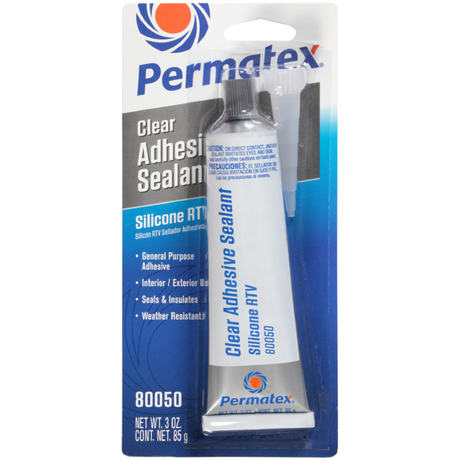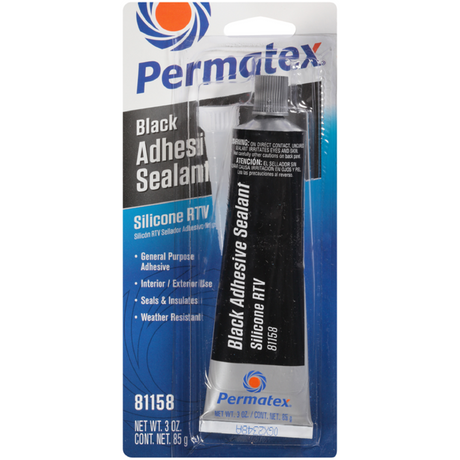Sealants
(1 products)- Featured
- Best selling
- Alphabetically, A-Z
- Alphabetically, Z-A
- Price, low to high
- Price, high to low
- Date, old to new
- Date, new to old
FiltersFilter & Sort
Permatex RTV Silicone Adhesive
From $7.90 USD$8.32 USDUnit price /Unavailable
Sealants are essential compounds used in various industrial applications to seal, bond, and protect surfaces from environmental factors such as air, moisture, dust, and chemicals. These versatile materials are critical for ensuring the durability and longevity of different products across industries like construction, automotive, electrical, plumbing, and even DIY projects.
At Wired4Signs USA, we offer high-quality silicone sealants that are perfect for industrial use. Our range includes both clear and black silicone sealants, designed for versatile use in a wide variety of environments. Whether you are installing waterproof LED strips, neon flexible LEDs, or sealing end caps, our silicone sealants ensure long-lasting protection and superior bonding.
What is Silicone Sealant?
Silicone sealant is a flexible, rubber-like material made from silicone polymers. Known for its strong adhesive properties, it is widely used in industrial, commercial, and DIY applications. Silicone sealants, like our Permatex RTV Silicone Adhesive are perfect for sealing and bonding, making them an ideal solution for a variety of projects that require durability and flexibility.
Key Features of Silicone Sealants:
- Flexible & Waterproof: Silicone sealant offers excellent flexibility, allowing it to adapt to movement without breaking or cracking. It is also highly resistant to moisture, making it ideal for both indoor and outdoor use.
- Resistant to Extreme Temperatures, UV Light, and Chemicals: Silicone sealants maintain their integrity under extreme temperatures and exposure to UV light, making them perfect for long-term outdoor applications.
- Excellent Adhesion: They bond securely to a wide range of materials, including glass, metal, plastic, and more, providing reliable performance across various surfaces and environments.
Common Uses for Silicone Sealants
Silicone sealants are used in a wide variety of applications due to their versatility and durability. Some of the most common uses include:
- Construction: Sealing gaps and joints in windows, doors, and frames, ensuring energy efficiency and preventing air or water infiltration.
- LED Lighting Installations: Silicone sealants are perfect for sealing end caps on waterproof LED strips and neon flexible LEDs, protecting the electrical components from moisture damage.
- Automotive: Used for repairing vehicle parts, sealing gaskets, and ensuring the integrity of windshields.
- Electrical: Insulating electrical components and preventing moisture damage, ensuring long-lasting, safe connections.
- Plumbing: Sealing joints in pipes, sinks, bathtubs, and showers to prevent leaks and maintain a watertight seal.
- DIY Projects: From crafting to home repairs, silicone sealants provide a reliable solution for securing loose items or sealing gaps in DIY projects.
Do's and Don'ts of Working with Silicone Sealants
When using silicone sealants, it's essential to follow some basic guidelines to ensure proper application and long-lasting results. Here's a quick guide on the do's and don'ts of working with silicone sealants to get the best outcome for your projects.
Do’s:
- Clean Surfaces Thoroughly - Before applying silicone sealant, make sure the surfaces are clean, dry, and free of any dirt, dust, or oils. This ensures the sealant adheres properly and creates a strong bond. Use a cleaning solution appropriate for the material you're sealing to ensure optimal adhesion.
- Use the Correct Amount - Apply the right amount of silicone sealant—avoid using too much or too little. Excess sealant can cause messy applications and extended curing times. Using the correct amount ensures a neat, professional finish.
- Allow Sufficient Curing Time - Silicone sealants typically need 24 hours to fully cure. Avoid disturbing the application during this time to ensure the sealant sets properly. Curing time may vary depending on the product, so always check the manufacturer's instructions.
- Work in Well-Ventilated Areas - When working indoors, ensure proper ventilation to allow the sealant's fumes to dissipate. Silicone sealants can release strong odors and vapors that may irritate the respiratory system, so it's always best to work in a well-ventilated space.
Don’ts:
- Don't Apply on Oily or Dirty Surfaces - Silicone sealant won’t bond effectively to surfaces that are dirty or oily. If you try to apply sealant to an unclean surface, it may result in poor adhesion and lead to future leaks or failures.
- Don’t Use Excessive Amounts - Using too much silicone sealant can result in a messy application and longer curing times. Be careful not to over-apply. A thin, consistent layer is sufficient for most sealing tasks.
- Avoid Sensitive Electrical Components - Silicone sealants are not designed for use on electrical components without proper precautions. Always ensure the area is dry and free from electrical components before applying sealant to avoid damage or interference.
- Don’t Rush the Curing Process - Allow the silicone sealant to fully cure before touching or using the sealed area. Rushing the curing process may compromise the sealant’s performance and reduce its longevity.
Frequently Asked Questions
What is a general purpose silicone sealant?
A general-purpose silicone sealant is a versatile adhesive used to seal gaps, cracks, and joints in a variety of materials, such as wood, glass, metal, and ceramic. It is waterproof, flexible, and resistant to temperature changes, making it ideal for indoor and outdoor applications like sealing LED channels, LED neon strips and other lighting fixtures.
How long do silicone sealants last?
Silicone sealants typically last around 5 to 10 years, depending on factors like exposure to weather, moisture, and temperature fluctuations. Regular maintenance and proper application can help extend their lifespan.
What happens if silicone sealant gets wet before it cures?
If silicone sealant gets wet before it cures, it can prevent proper adhesion and curing. The moisture can interfere with the curing process, causing the sealant to remain soft, tacky, or fail to bond effectively to the surface. For best results, it's important to allow silicone sealant to cure in dry conditions as recommended by the manufacturer.
How do you know if silicone sealant is cured?
You can tell if silicone sealant is cured by checking its surface and firmness. Typically, silicone sealant cures within 24 to 48 hours, depending on the thickness and the environmental conditions. To test, press the surface lightly with your finger; if it feels dry and firm without leaving an impression, it is cured. For deeper layers, allow more time as they may take longer to fully cure. Always refer to the product's instructions for specific curing times.
Is it OK to put new silicone over old silicone?
It's generally not recommended to apply new silicone over old silicone. The old silicone may not bond properly to the new layer, leading to peeling or reduced effectiveness. It's best to remove the old silicone completely before applying a fresh layer for optimal adhesion and durability.
Should I remove old silicone sealant before applying new?
Yes, you should remove old silicone sealant before applying new. Old sealant can prevent the new one from adhering properly, which may lead to leaks or poor sealing.
Your cart


